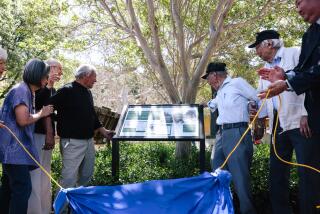Lithuanian Prison Echoes Era of KGB
- Share via
VILNIUS, Lithuania — Juozas Aleksejunas unlocked the door of the cold, concrete cell and stepped carefully inside. More than 50 years ago, as a young Lithuanian independence fighter, he spent three freezing days in solitary confinement in the little room.
Now he has a job showing the cell to visitors--along with rest of the brutal KGB jail where he was held for two months before spending 18 years in a Soviet labor camp.
In independent Lithuania, the hated Soviet prison has become a little museum of horrors, and the former prisoners have become the keepers.
“Today, I don’t really feel anything,” Aleksejunas said. “But when I first came back, I couldn’t even walk along this street. I had to walk the long way around. I was trembling all over every time.”
After Soviet troops retook Lithuania from the Nazis in 1943, the KGB carried out a ruthless campaign to extinguish the Lithuanian independence movement.
Hundreds of thousands of people were deported to gulags in other parts of the Soviet Union.
In 1990, Lithuania became the first Soviet republic to declare independence, and it moved quickly to expunge all traces of the Communist occupation--including the large statue of Soviet founder V.I. Lenin that had loomed over the area of the KGB jail.
Today, only a few reminders of the Soviet era remain, such as the KGB Museum and the simple wooden crosses at the capital’s television tower, where 13 people were killed in a Soviet tank assault in 1990.
Before the fall of the Soviet Union, the KGB began destroying files that contained evidence of its brutal activities. In one room of the KGB Museum, dozens of large bags of shredded documents are on display.
Aleksejunas, 76, walks down the hall between the jail cells as if he owned the place, swinging the large key to the doors and pointing out the grim history of each room:
Here is the cell where captured partisans were kept before they were interrogated and tortured. Here is the cell where the leader of the independence forces, Adolfas Ramanauskas, was beaten in 1957 before he was shot.
“In the beginning, it was really strange,” Aleksejunas said. “Then I thought, ‘You have to work here to tell people what was happening,’ and I got used to it.”
Some of the cells would take a lot of getting used to. Bloodstains are still visible on the wall of a padded cell. On display in another cell is a black shirt similar to a straitjacket that could be used to break a prisoner’s spine.
“Sometimes they put a man in here for three days without torturing him, and it was enough to drive him mad,” Aleksejunas said.
Two other cells were reserved for prisoners who would not talk. In Soviet days, the floor was covered with 6 inches of cold water; in the center, just above water level, was a metal disk barely large enough to stand on. Prisoners were placed in the cell naked for up to 36 hours. A guard was posted to make sure they did not drown.
In an interrogation cell, Aleksejunas demonstrated another KGB technique: A prisoner was forced to sit on the corner of a stool while a guard, standing above, would strike the prisoner on the back of the neck, driving his tailbone painfully into the seat.
“When I was questioned here, the guards beat me so much I couldn’t pull myself together for two days,” he said.
Prisoners sentenced to die were kept in a special cell and taken one by one to another room to be shot. In all, 700 people were executed at the prison between 1944 and 1947.
*
Aleksejunas was captured in the forest in 1945 after spending two years fighting the Communists. He was sent to a gulag in Vorkuta in Russia’s Far North, where he helped build railways and buildings. When he returned to Vilnius in 1963, he could not legally work or find an apartment for a year. Finally, he got a job as an electrician at the local power plant and worked there 25 years.
One of his clearest memories is the three days he spent shivering in the isolation cell at the prison in downtown Vilnius. Each day, he was given only 11 ounces of rice and one glass of water.
His infraction? “I looked into the eyes of an officer,” Aleksejunas said, “and it seemed to him I was mocking him.”
More to Read
Sign up for Essential California
The most important California stories and recommendations in your inbox every morning.
You may occasionally receive promotional content from the Los Angeles Times.













